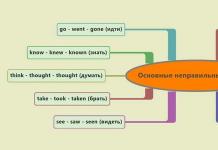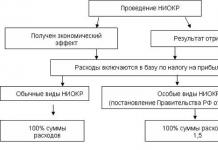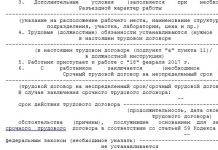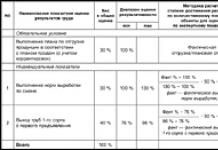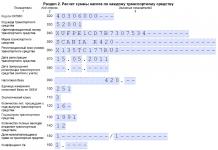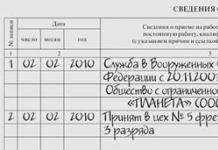For 2018. In the last issue we looked at changes to the Unified Chart of Accounts. Continuing the topic started, in this article we will provide an overview of the main innovations in the instructions itself.
The need to adjust Instruction No. 157n is due to certain federal standards for public sector organizations that entered into force in 2018 and innovations in the application of KOSGU, namely:
GHS “Conceptual Framework”;
GHS “Fixed Assets”;
GHS "Rent";
GHS Impairment of Assets;
by orders of the Ministry of Finance of the Russian Federation dated December 27, 2017 No. 255n, dated November 29, 2017 No. 209n.
Instruction No. 157n now explicitly states that it is applied simultaneously with the GHS “Conceptual Framework”, and the text of Instruction No. 157n has been supplemented with references to the above-mentioned federal standards.
The main changes affected the sections “General Provisions” and “Non-Financial Assets”; we will discuss them further.
Section "General provisions".
This section excludes certain provisions that duplicate the rules of the GHS “Conceptual Framework”, including provisions on the preparation and submission of primary accounting documents and on the procedure for conducting an inventory of assets and liabilities.
Some provisions are set out in a new edition.
In paragraph 3 of Instruction No. 157n it is clarified that when maintaining accounting records, the accounting entity ensures priority recognition in accounting of expenses and liabilities over the recognition of possible income and assets, reflecting these accounting objects according to the most conservative estimates - without overstating assets and (or) income and not underestimating liabilities and (or) expenses (principle of prudence). This principle was provided for earlier, but there was no explanation of what is meant by it.
In paragraph 6 of Instruction No. 157n, the composition of the accounting policy has been adjusted. In fact, the update of this paragraph did not make significant changes. The only thing that can be highlighted is the rules of document flow, which should also be part of the accounting policy. Previously, a similar provision was contained in paragraph 9 (it was deleted).
Paragraph 14 of Instruction No. 157n now clarifies that the storage of primary (consolidated) accounting documents, accounting registers and accounting (financial) statements is organized by the accounting entity and (or) the head of the centralized accounting department.
In addition, the same paragraph now contains a provision that when there is a change in the head of the accounting entity and (or) the chief accountant or other official entrusted with accounting, the transfer of the institution’s accounting documents is ensured. The procedure for transferring these documents must be provided for in the accounting policy, and in the case of transferring the powers of accounting under a contract (agreement) to centralized accounting - by such contract (agreement).
Section "Non-financial assets".
Lease objects are classified as non-financial assets. In paragraph 22 of Instruction No. 157n, an addition was made that the accounts for accounting for non-financial assets also take into account property received for free use, in trust, and rental accounting objects related to fixed assets for accounting purposes.
On a note:
The rules for determining the initial cost of non-financial assets have been adjusted. Corresponding amendments have been made to clauses 23 – 26 of Instruction No. 157n.
The initial cost of non-financial assets is recognized as the amount of actual costs when acquiring as a result of exchange transactions, construction or production (creation) of non-financial assets, taking into account the amounts of value added tax presented to the institution by suppliers and (or) contractors (except for the acquisition, construction and production of non-financial assets within activities of an institution subject to VAT), unless otherwise provided by Instruction No. 157n.
The initial (actual) cost of objects of non-financial assets received under agreements providing for the fulfillment of obligations (payment) in non-monetary means is recognized as the value of assets transferred or to be transferred by the institution in order to fulfill obligations under the agreement. The value of items transferred or to be transferred by an institution is determined at their fair value based on the price at which, in comparable circumstances, the institution would normally determine the value of similar items (at which similar non-financial assets would be purchased in comparable circumstances). If the fair value of assets transferred or to be transferred by the institution is not possible, the value of non-financial assets received by the institution under these agreements is determined based on the residual (book) value of the asset transferred in exchange. If data on the residual value of the asset transferred in exchange is for some reason unavailable, or on the date of transfer the residual value of the asset transferred in exchange is zero, such an object of non-financial assets is reflected by the institution in a conditional valuation: one object - one ruble.
The initial (actual) cost of objects of non-financial assets received by an institution under a non-exchange transaction (free of charge, including under a gift agreement) is their current estimated value on the date of acceptance for accounting, recognized as the fair value of these objects, increased by the cost of services related to their delivery, registration and bringing them into a condition suitable for use.
The current estimated value of a non-financial asset is determined by the market price method based on data on transactions with a similar or similar asset made without deferred payment, and is made in the amount of funds required for the sale (purchase) of these assets on the date of acceptance for accounting.
The current estimated value for the purpose of accepting a non-financial asset for accounting is determined on the basis of the price in effect on the date of acceptance for accounting (capitalization) of property received free of charge for this or a similar type of property. Information about the current price must be confirmed by documents, and in cases where documentary confirmation is not possible - by expert means.
Read also
- Changes have been made to Instruction No. 157n
- We are reviewing the accounting policies for 2018
- Inventory: preparing for the preparation of annual reporting forms
- New in fixed asset accounting in 2018
- Guidelines of the Ministry of Finance on the application of the GHS “Fixed Assets”
When determining the current estimated value for the purpose of accepting a non-financial asset for accounting by the commission for the receipt and disposal of assets created in the institution on an ongoing basis, data on prices for similar material assets received in writing from manufacturing organizations are used; information on the price level available from state statistical bodies, as well as in the media and specialized literature, expert opinions (including experts recruited on a voluntary basis to work in the commission on the receipt and disposal of assets) on the cost of individual (similar) objects non-financial assets.
If data on prices for similar or similar material assets is unavailable for some reason, in order to ensure continuous accounting and complete reflection of accomplished facts of economic activity, the current estimated value is recognized in a conditional valuation equal to one ruble. At the same time, the specified material assets that meet the criteria for asset recognition are reflected by the accounting entity on balance sheet accounts in a conditional valuation: one object - one ruble.
After receiving data on prices for similar or similar tangible assets for an object of a non-financial asset (tangible asset), reflected as of the date of recognition in the conditional valuation, the accounting entity’s commission revises the book (fair) value of such an object.
The initial (book) value of lease accounting objects is determined in accordance with the GHS “Lease”.
Impairment of an asset results in a change in its carrying amount. Clause 27 of Instruction No. 157n names cases when the book value of non-financial assets changes. These include:
completion;
retrofitting;
reconstruction;
technical re-equipment;
modernization;
partial liquidation (dismantling);
revaluation of non-financial assets;
impairment.
According to the amendments, this paragraph was supplemented with the last position.
Reflection of non-financial assets upon their alienation. Due to the additions made to clause 28 of Instruction No. 157n, non-financial assets, with the exception of finished products and goods intended for disposal not in favor of public sector organizations, are reflected in accounting at fair value determined by the market price method.
The result of revaluation to fair value, determined by the market price method, is reflected in accounting and disclosed in the accounting (financial) statements separately as part of the result of the current period.
Features of accounting for non-financial assets received through non-exchange transactions. According to the updated clause 32 of Instruction No. 157n, tangible objects of non-financial assets received by an institution through non-exchange transactions, before they are recognized as part of balance sheet accounting items (assets), are taken into account by the accounting entity in the corresponding off-balance sheet accounts at the cost indicated upon their receipt, and in cases where there is no such – in conditional valuation: one object – one ruble.
Material objects of non-financial assets in use by the institution, provided by the balance sheet holder in the performance of the functions assigned to him for organizational and technical support of other institutions (authorities) created by the owner of the property, and for the maintenance of state (municipal) property, are taken into account by the subject of accounting on the corresponding off-balance sheet accounts according to the value indicated upon their receipt (transfer).
Accounting for objects that do not bring economic benefits In accordance with the amendments made to clauses 34, 35 of Instruction No. 157n, objects of non-financial assets that do not bring economic benefits to the institution, do not have useful potential, in respect of which it is also not envisaged to receive them in the future, including including in connection with the complete or partial loss of consumer properties, technical potential (physical or moral wear and tear), are recorded on off-balance sheet accounts. Termination of recognition of an object as an asset is carried out on the basis of a decision of the permanent commission for the receipt and disposal of assets, drawn up in a supporting document (primary (consolidated) accounting document). Information about such objects is subject to disclosure in accounting (financial) statements.
On a note:
To account for the institution’s material assets that do not meet the asset criteria, account 02 “Tangible assets in storage” is used.
The grouping of analytical codes of the synthetic account has been adjusted. According to clause 37 of Instruction No. 157n, accounting for non-financial assets is carried out according to the following analytical groups of the synthetic account of the Unified Chart of Accounts:
1. By property:
10 “Real estate of the institution”;
20 “Especially valuable institutions”;
30 “Other movable property of the institution”;
40 “Rights to use assets”;
50 “Non-financial assets that make up the treasury”;
90 “Property in concession”.
2. According to the costs of production of finished products, works, services:
60 “Cost of finished products, works, services”;
70 “Overhead costs of production of finished products, works, services”;
80 “General business expenses”.
Previously, group 40 reflected leasing objects, now - the rights to use assets (in relation to property leased by the institution). Previously, group 90 was intended to account for distribution costs, but is now used to account for property in a concession.
Changes in fixed asset accounting.
In Instruction No. 157n, some provisions that duplicate the GHS standards “Fixed Assets” have been abolished. Certain paragraphs have been supplemented with new provisions.
Biological resources. A new paragraph has been introduced into paragraph 45 of Instruction No. 157n, clarifying that the “Biological Resources” accounting group includes service dogs, perennial plantings, horses and other objects of animal (live animals) and plant origin (trees and other perennial crops, for example, orchards, vineyards, other plantations), repeatedly producing products whose natural growth and restoration are under the direct control of the accounting entity.
The procedure for assigning an inventory number has been supplemented with new provisions. According to the amendments made to clause 46 of Instruction No. 157n, each inventory item of real estate, as well as an inventory item of movable property, with the exception of items worth up to 10,000 rubles. inclusive, and objects of the library collection, regardless of their value, are assigned a unique inventory serial number, regardless of whether it is in operation, in reserve or in conservation.
Each fixed asset object included in a complex of fixed asset objects, recognized for accounting purposes as a single inventory object, is assigned an internal serial inventory number of the complex of objects, formed as a combination of the inventory number of the complex of objects and the serial number of the object included in the complex.
Objects of fixed assets that have a unique number that uniquely identifies them as an individually defined thing (for example, a cadastral number, a state (registration) identification mark (number) of a vehicle, a serial number of a manufactured weapon) are assigned an inventory number without applying it to the object .
When reclassifying fixed assets, the inventory number does not change (including if the accounting group of non-financial assets is changed, when objects listed on off-balance sheet accounts are accepted for balance sheet accounting). Corresponding amendments have been made to clause 47 of Instruction No. 157n.
Accounting for inseparable improvements to property objects that are objects of accounting for operating leases (formation of their inventory numbers) is carried out by ensuring the identification of each inventory object with the corresponding right to use the asset (clause 49 of Instruction No. 157n).
Accounting for fixed assets worth up to 10,000 rubles. In accordance with the updated paragraph 50 of Instruction No. 157n, the initial cost of movable property objects put into operation (transferred) that are fixed assets worth up to 10,000 rubles. inclusive, with the exception of library collection objects, is written off from the balance sheet while simultaneously reflecting the objects on an off-balance sheet account.
On a note:
In order to ensure proper control over the movement of fixed assets in operation by the institution worth up to 10,000 rubles. inclusive, with the exception of library collection objects and real estate objects, off-balance sheet account 21 “Fixed assets in operation” is intended.
Disposal of fixed assets from accounting. Due to the additions made to clause 52 of Instruction No. 157n, to reflect in accounting transactions on the disposal of fixed assets from off-balance sheet account 02 “Tangible assets in storage” or from the corresponding analytical accounts 101 00 000 “Fixed assets”, acts are accepted if available on them, approval of the decision to write off fixed assets in cases provided for by the legislation of the Russian Federation, with the owner of the property (with the body exercising the functions and powers of the founder) and the approving inscription of the head of the institution.
Reflection in the accounting records of the disposal of a fixed asset item from off-balance sheet account 02 before the decision on the write-off (disposal) of the said object is approved in the prescribed manner and the implementation of the measures provided for in the write-off act is not allowed.
The grouping of fixed assets is brought into compliance with the GHS standards “Fixed assets”.
Changes in accounting for non-produced assets.
According to the additions made to clause 71 of Instruction No. 157n, land plots used by institutions on the right of permanent (perpetual) use (including those located under real estate), as well as land plots for which property is not demarcated, are involved by authorized authorities ( local government bodies) into economic circulation, are taken into account in the corresponding analytical accounting account account 103 00 000 “Non-produced assets” on the basis of a document (certificate) confirming the right to use the land plot, at their cadastral value (the value specified in the document for the right to use the land plot located outside the territory of the Russian Federation), and in the absence of a cadastral value of a land plot - at a value calculated based on the lowest cadastral value per square meter of a land plot bordering the object of registration, and if it is impossible to determine such a value - in a conditional valuation: one square meter - one ruble.
Depreciation of non-financial assets
In accordance with the amendments made to clause 92 of Instruction No. 157n, depreciation for fixed assets is calculated in accordance with the GHS “Fixed Assets”.
Depreciation of the right to use assets is calculated in accordance with the GHS “Rent”.
The depreciation procedure for intangible assets has also been adjusted (clause 93 of Instruction No. 157n):
for objects worth up to 100,000 rubles. inclusive, depreciation is charged in the amount of 100% of the book value when the object is registered;
for objects worth over 100,000 rubles. depreciation is accrued in accordance with depreciation rates calculated in accordance with the established procedure.
Rights to use assets.
Accounting for the rights to use assets (operating lease objects) is carried out in accordance with the GHS “Lease” and the newly introduced clauses 151.1 – 151.4 of Instruction No. 157n. For these purposes, account 111 00 000 is now designated in the Unified Chart of Accounts. Analytical accounting is carried out on it for objects received for use, and for copyright holders (lessors) in the context of contracts, locations of property received for use, as well as persons for the safety such objects and (or) their intended use.
Rights to use assets are accounted for according to the corresponding analytical code of the type of synthetic account of the accounting object:
41 “Rights to use residential premises”;
42 “Rights to use non-residential premises (buildings and structures)”;
44 “Rights to use machinery and equipment”;
45 “Rights to use vehicles”;
46 “Rights to use industrial and household equipment”;
47 “Rights to use biological resources”;
48 “Rights to use other fixed assets.”
Accounting for transactions on disposal (reclassification) of the right to use assets is kept in the journal of transactions on disposal and transfer of non-financial assets.
Impairment of non-financial assets
Impairment of non-financial assets is reflected in accounting in accordance with the GHS “Impairment of Assets” and new clauses 151.5 – 151.7 of Instruction No. 157n. According to the changes made, to account for the decrease in the value of assets due to their impairment, account 114,00,000 is used for the corresponding analytical groups of the synthetic account of the accounting object:
10 “Depreciation of the institution’s real estate”;
20 “Depreciation of particularly valuable movable property of an institution”;
30 “Depreciation of other movable property of the institution”;
40 “Impairment of rights to use assets.”
Accounting for asset impairment transactions is also maintained in the journal of transactions on disposal and transfer of non-financial assets.
Summarizing the above, we note that changes were also made to the sections “Financial assets”, “Financial result”, they affected the procedure for applying new accounts for income (in connection with the detailing of KOSGU) and for accounting for financial results (in terms of accounts to reflect corrections of errors previous years). Adjustments have also been made to the procedure for using off-balance sheet accounts.
Corresponding amendments have also been made to instruction No. 183n. Accountants of state (municipal) institutions have been waiting for these changes since the beginning of the year. And now in accounting it is necessary to reflect operations on the transition to a new procedure for accounting for operations on fixed assets and leases, as well as on the income and expenses of the institution.
Let us recall that the Ministry of Finance in letters dated December 15, 2017 No. 02-07-07/84237, dated December 13, 2017 No. 02-07-07/83464, No. 02-07-07/83463 gave clarifications on the transitional provisions for the application of the GHS “Basic funds" and "Rent" (including correspondence accounts), but it was not possible to fully apply them in practice until amendments were made to the main instructions.
It should be noted that at the time of preparation of this material there were no explanations on how to transfer balances to new accounts. Perhaps the Ministry of Finance will prepare additional recommendations in the near future.
non-financial assets fixed assets rent
Not every accountant working in a commercial organization will be able to instantly switch to working in the budget accounting system. It is conducted according to rules that differ from those prescribed for commercial sector enterprises and non-profit organizations.
This difference is due to peculiarity of the legal status of such institutions. Their founders are either government bodies at any level, or municipal bodies, or ministries and departments at the federal level. These organizations are recipients of public funds distributed in the form of subsidies or budgeted financing, control over the expenditure of which is much stricter than in the private sector of the economy.
Therefore, the regulations governing this area differ from similar ones developed for entrepreneurship. There are no significant changes for 2019.
From a methodology point of view, the main difference between the two accounting systems is Chart of accounts. The second important difference between budget accounting and accounting after the names and numbering of accounts is procedure for generating and submitting reporting forms. It is provided not only to the tax authorities, but also to the founder of the organization.
 The main documents regulating budget accounting are instructions issued by the Ministry of Finance, which also regulates accounting. They are both general and private in nature, relating to the activities of only one type of institution.
The main documents regulating budget accounting are instructions issued by the Ministry of Finance, which also regulates accounting. They are both general and private in nature, relating to the activities of only one type of institution.
Budgetary institutions are divided into three main groups– budgetary, autonomous and state-owned.
Each group has its own chart of accounts, reflecting the differences in the specifics of their activities and their regulation.
- Budgetary institutions are created in the fields of science, education, and culture. They are financed from the founder’s budget, and they manage their income independently.
- State institutions work in the sphere of production and science, perform certain government functions or public services, are financed from the budget on the basis of an approved estimate, their activities are related to the use of money, they have their own income, which creates the need for specific regulation of their financial and budgetary discipline.
- Autonomous organizations are created mainly in the field of social support of the population, science, education, sports and other areas related to the provision of services to citizens. They are also financed from the founder’s budget; they manage their income independently. Their difference is that they can open current accounts in commercial banks, and not just in the Federal Treasury.
The main feature of all types is that they use their property on the basis of the right of operational management; they receive funding from the founder or directly from the budget, which gives rise to special reporting requirements.
To understand the requirements for the preparation and submission of reports, the accountant must know the classification of budget accounting entities. This mechanism involves three groups of subjects:
- recipients of funds (institutions);
- fund managers (founders or regional authorities that direct funds to their recipients);
- the main manager of funds (usually the federal ministry when distributing funds between autonomous organizations).
The recipient of the funds reports to the managers by preparing reports that are almost similar to those sent to the tax authorities.
 A single Chart of Accounts for budget accounting, common to all groups of this type of legal entity, can be found in Instruction No. 157n. For 2019 it has undergone major changes.
A single Chart of Accounts for budget accounting, common to all groups of this type of legal entity, can be found in Instruction No. 157n. For 2019 it has undergone major changes.
An important change was adjustments in the names of many accounts, for example, account 10407 “Depreciation of the library fund” was renamed “Depreciation of biological resources”, account 10707 “Library fund” - “Biological resources”. Based on the Unified Chart of Accounts, illogical plans are developed for each type of budgetary organization.
New accounts were introduced, for example, 10429 “Depreciation of intangible assets - especially valuable movable property of an institution”, 10449 “Depreciation of rights to use non-produced assets”.
Accounts 10540 “Inventory - leased items”, 10240 “Intangible assets - leased items”, 10740 “Leased items in transit”, 10990 “Distribution costs” have become invalid.
The nomenclature of accounts specifically for budgetary institutions is regulated by Instruction No. 174n, it introduces the Unified Chart of Accounts and the procedure for its application, it, like 157n, was seriously changed twice, by the same orders of the Ministry of Finance.
Instruction No. 191n introduces requirements for reporting on budget execution. This is a special form of reporting; 6 types of balance sheet forms alone are offered. The choice of form depends on whether the organization is the recipient, manager or main manager of budget funds.
And finally, Instruction No. 148n regulates general issues of budget accounting. It regulates the rules for recording each business transaction,
Types of calculations
For any accountant of a budgetary institution, one of the most important areas of application of the rules of budget accounting will be the reflection in it of settlements with different groups of debtors and creditors.
With accountable persons
Strict control over all types of spending of funds also applies to. There is still a requirement to issue cash receipts when issuing cash. Employees report on an advance report with supporting documents (for commercial organizations these features of document flow have already been abolished). Calculations on the synthetic account 020800000, which has a large number of analytical accounts, are taken into account.
 If in commercial organizations failure to deliver is a private matter, then in an institution it is a violation of budget discipline. Shortages, as understood by the legislator when developing the wording of this article, are of a different nature depending on the asset and the reasons for its loss:
If in commercial organizations failure to deliver is a private matter, then in an institution it is a violation of budget discipline. Shortages, as understood by the legislator when developing the wording of this article, are of a different nature depending on the asset and the reasons for its loss:
- movable property;
- Money;
- as a result of dishonest actions;
- in the form of legal costs.
Calculations for these types of shortfalls are reflected according to account 020900000 “Calculations for damage and other income”. Here, according to the norms of paragraph 220 of Instruction No. 157n, not only shortfalls are taken into account, but also theft, timely unreturned funds issued according to the advance report, advance payments unreturned by counterparties for terminated government contracts, and the amount of legal costs.
With the founder
For all types of institutions, their founder will be a government agency or a specific ministry. It endows the institution with property. Settlements with the founder are one of the main types of settlements and their inaccurate or untimely execution and recording may lead to the application of liability measures against authorized persons. Transactions are recorded either annually or before the organization is converted to another form.
They are reflected on account 021006000. This account must necessarily reflect the property transferred to the organization by the founder, which it cannot dispose of independently, but uses the income received from it. This property includes real estate and other expensive fixed assets. It also reflects the so-called “especially valuable movable property” (the term was introduced by one of the instructions), which the organization acquired independently, using income from its activities.
Together with the property itself, the amount of depreciation accrued on it must be reflected, which remains here in the event of disposal of the property from management before its full depreciation. Targeted subsidies and the return of their unspent portion are also reflected here.
With other debtors
This type of calculation is reflected in the synthetic account 021005000“Accounts with debtors based on income” and accompanying analytical accounts. Overpayments of taxes are taken into account in the same account. It should be borne in mind that most expenses must be authorized by the founder, either in the form of approval of the estimate, or in the form of granting permission to carry out a specific expenditure transaction.
On subaccount 020502000 income from property is reflected on 020503000 – income from sales. All transactions are additionally reflected in journals maintained according to established forms.
Thus, all the rules governing accounting in budgetary organizations differ significantly from the rules of RAS; in addition, they have undergone a number of structural changes associated with changes in budget classification and the strengthening of the role of electronic document management in relations between government bodies.
In order to navigate all these changes, an accountant needs to devote time to studying the instructions. In this case, records will be kept in accordance with the new rules and there will be no problems associated with reporting.
Amendments are being made to Instruction No. 157n (O. Zabolonkova)
Date of article posting: 06/13/2015
The Order of the Ministry of Finance of Russia dated August 29, 2014 N 89n “On amendments to the order of the Ministry of Finance of the Russian Federation dated December 1, 2010 N 157n” “On approval of the Unified Chart of Accounts for public authorities (state bodies), bodies” is being registered with the Ministry of Justice. local self-government, management bodies of state extra-budgetary funds, state academies of sciences, state (municipal) institutions and the Instructions for its application" (hereinafter - Order No. 89n, Instruction No. 157n). Let's consider the main provisions of this document.
Changes in the Unified Chart of Accounts
Let us recall that Appendix 1 to Instruction No. 157n contains the Unified Chart of Accounts. The following amendments have been made to it:
- account names have been changed:
|
Account number |
Old name |
New name |
|
Cash in the institution's accounts with a credit institution |
Funds of the institution in a credit institution |
|
|
Calculations for property damage |
Calculations for damage and other income |
|
|
Calculations for other property |
Calculations for other income |
|
|
Accepted obligations |
Liabilities |
- account excluded:
- new accounts have been introduced:
|
Account number |
Name |
|
Balance accounts |
|
|
Calculations for unidentified receipts |
|
|
Cost compensation calculations |
|
|
Calculations of forced seizure amounts |
|
|
Calculations for other income |
|
|
VAT calculations on advances received |
|
|
VAT calculations on purchased material assets, works, services |
|
|
Reserves for future expenses (by type of expense) |
|
|
Authorization for other subsequent years (outside the planning period) |
|
|
Obligations accepted |
|
|
Deferred liabilities |
|
|
Off-balance sheet accounts |
|
|
Material assets issued for personal use to employees (employees) |
|
|
Calculations for the fulfillment of monetary obligations through third parties |
|
Changes in general accounting provisions
Requirements for accounting documents. Clause 3 of Instruction No. 157n lists the requirements for accounting. By Order No. 89n they are expanded by the following provisions:
Primary accounting documents received as a result of internal control of completed facts of economic life for registration of the data contained in them in accounting registers are accepted for accounting, on the assumption of proper preparation of primary accounting documents on completed facts of economic life by the persons responsible for their registration;
Accounting data and the reporting of accounting entities generated on their basis are formed taking into account the materiality of the facts of economic life that have had or may have an impact on the financial condition, cash flow or results of operations of the institution and took place in the period between the reporting date and the date of signing the accounting (financial) ) reporting for the reporting year (hereinafter referred to as the event after the reporting date).
Based on clause 9 of Instruction No. 157n (in the new edition), timely and high-quality execution of primary accounting documents, their transfer within the established time frame for reflection in accounting, as well as the reliability of the data contained in them are ensured by persons those responsible for registration of the fact of economic life and (or) those who signed these documents. Order No. 89n introduced an addition to this paragraph, according to which the person entrusted with maintaining accounting records and the person with whom an agreement for the provision of services (agreement on the transfer of powers) for maintaining accounting (budget) records was concluded are not responsible for the compliance of the drawn up other persons of primary accounting documents to accomplished facts of economic life.
The requirements for the forms of accounting registers have been supplemented with new provisions. In particular, it is established that registers, the forms of which are not unified, are established by the accounting entity as part of the formation of its accounting policies and must contain the following mandatory details:
Register name;
Name of the accounting entity that compiled the register;
The start date and end date of maintaining the register and (or) the period for which the register was compiled;
Chronological and (or) systematic grouping of accounting objects;
The amount of monetary and (or) natural measurement of accounting objects, indicating the unit of measurement;
Names of positions of persons responsible for maintaining the register;
Signatures of the persons responsible for maintaining the register, indicating their last names and initials or other details necessary to identify these persons.
In addition, a provision has been introduced clarifying that corrections are reflected in the electronic accounting register by persons responsible for maintaining the register in the manner prescribed by clause 18 of Instruction No. 157n, with records confirmed by certificates.
Automation of accounting. The following requirements are imposed on the automation of accounting, taking into account the changes made by Order No. 89n to clause 19 of Instruction No. 157n.
With comprehensive automation of accounting, information about accounting objects is generated in the databases of the software package used. The formation of accounting registers is carried out in the form of an electronic register, and in the absence of technical capabilities - on paper.
Accounting registers on paper, if there is no possibility of storing them in the form of electronic documents signed with an electronic signature, and (or) the need to ensure their storage on paper, are formed at the frequency established as part of the formation of accounting policies by the subject of accounting, but not less frequently than the frequency established for the preparation and presentation by the accounting entity of accounting (financial) statements generated on the basis of data from the relevant accounting registers.
As before, when transferring accounting registers to paper (generating machine diagrams of accounting registers), it is allowed to differ between the output form of the document (machine diagram) and the approved form of the document, provided that the details and indicators of the output form of the document (machine diagram) contain the mandatory details and indicators of the corresponding accounting registers.
Inventory. It is important to note the following point. According to the amendments made to clause 20 of Instruction No. 157n, the inventory of property, financial assets and liabilities is carried out by the accounting entity in the manner established by him as part of the formation of accounting policies taking into account the provisions of the legislation of the Russian Federation. Previously, it was necessary to conduct an inventory in accordance with the requirements of the Ministry of Finance.
Changes in accounting for non-financial assets
Fixed assets. Let us recall: clause 27 of Instruction No. 157n establishes that the book value of non-financial assets is their original cost, taking into account its changes.
Order No. 89n introduced an addition, according to which the result of repair work on an object of fixed assets that does not change its value (including the replacement of elements in a complex object of fixed assets (in a complex of structurally articulated objects that constitute a single whole)) is subject to reflection in the accounting register - inventory card of the corresponding fixed asset object - by making entries about the changes made without being reflected in the accounting accounts.
In addition, the features of accounting for fixed assets under conservation are explained. In particular, clause 38 of Instruction No. 157n as amended by Order No. 89n establishes that the mothballing of a fixed asset object for a period of more than three months (re-mothballing) is formalized by a primary accounting document - an act on conservation (re-mothballing) of fixed assets, containing information about the accounting object ( name, inventory number of the object, its original (book) value, amount of accrued depreciation), as well as information about the reasons for conservation and the period of conservation.
An object of fixed assets that is under conservation continues to be listed on the corresponding balance sheet accounts of the working chart of accounts of the institution as an object of fixed assets.
Reflection of conservation (re-preservation) of an object of fixed assets for a period of more than three months is reflected by making a record of conservation (re-preservation) of the object in the inventory card of the accounting object, without reflecting account 0 101 00 000 “Fixed assets” in the corresponding analytical accounts.
Clause 45 of Instruction No. 157n provides a definition of the unit of accounting for a fixed asset - an inventory item.
The provisions of Order No. 89n further clarify that:
Separate premises of buildings that have different functional purposes, and are also independent objects of property rights, are accounted for as independent inventory objects of fixed assets;
The road environment (technical means of organizing traffic, including road signs, fencing, markings, guide devices, traffic lights, automated traffic control systems, lighting networks, landscaping and small architectural forms) is taken into account as part of the road, unless otherwise established by the procedure for maintaining the register property of the relevant public legal entity;
In cases provided for by the accounting policies of accounting entities, aircraft engines are accounted for as independent inventory items of fixed assets.
Land is a non-produced asset. According to paragraphs 23, 71 of Instruction No. 157n (as amended by Order No. 89n), land plots used by institutions on the right of permanent (perpetual) use (including those located under real estate) must be accounted for as part of non-financial assets on the balance sheet account 103 00 “Non-produced assets” on the basis of a document (certificate) confirming the right to use the land plot. Land plots are accounted for at their cadastral value (the value specified in the document for the right to use a land plot located outside the territory of the Russian Federation).
Let us recall that currently Instruction No. 157n requires such land plots to be accounted for in off-balance sheet account 01 “Property received for use.” Therefore, they now need to be transferred from this account to the balance sheet account.
Changes in accounting for financial assets
The institution's funds are on the way. By virtue of clause 162 of Instruction No. 157n (as amended by Order No. 89n), account 201 03 is intended to account for operations on the movement of funds of the institution in the currency of the Russian Federation and in foreign currency in transit. For accounting purposes and Instruction No. 157n, funds in transit are funds transferred to an institution, credited on more than one business day, as well as funds transferred from one account of an institution to another account, including when carrying out transactions using (debit) bank cards, provided that funds are transferred (credited) on more than one business day.
As you can see, the new edition of this paragraph is due to the use of bank cards by institutions in financial activities.
Calculations with accountable persons. The changes affected accountable amounts issued in foreign currency. Paragraph 215 of Instruction No. 157n establishes that the accounting of debts of accountable persons for advances issued in foreign currencies is simultaneously carried out in the corresponding foreign currency and in the ruble equivalent on the date of issuance of funds for reporting.
Order No. 89n introduces the following additions to this paragraph. Revaluation of settlements for advances issued in foreign currencies is carried out on the date of operations to return previously made payments in the corresponding foreign currency.
Revaluation of debt under accepted obligations in foreign currencies is carried out on the date of transactions to pay the obligation in foreign currency and on the reporting date (on the date of formation of the accounting register).
In this case, positive (negative) exchange rate differences that arose when calculating the ruble equivalent are attributed to the increase (decrease) in settlements for accepted obligations in foreign currency, with exchange rate differences being attributed to the financial result of the current financial year from the revaluation of assets.
Calculations for damage and other income. Order No. 89n added that account 209 00 is used, among other things, to account for settlements for amounts of advance payments not returned by the counterparty in the event of termination of contracts (other agreements), in particular by court decision, for amounts of debt of accountable persons not returned in a timely manner (not withheld from wages), on the amounts of debt for unworked vacation days when an employee is dismissed before the end of the working year for which he has already received annual paid leave, on the amounts of excessive payments made, on the amounts of forced withdrawal, including compensation for damages in in accordance with the legislation of the Russian Federation, in the event of insured events, as well as in the amount of damage caused as a result of the actions (inaction) of officials of the organization (clause 220 of Instruction No. 157n (as amended by Order No. 89n)).
In connection with the introduction of new analytical groups for account 209 00, paragraph 221 of Instruction No. 157n in the new edition provides the following explanations. Grouping of calculations for damage and other income is carried out by income groups and analytical groups of the synthetic account of the accounting object:
30 "Calculations for cost compensation";
40 “Calculations for forced seizure amounts”;
70 “Calculations for damage to non-financial assets”;
80 "Calculations for other income."
It is clarified that the accounts for settlements of damage and other income take into account:
Calculations of the amounts owed by former employees to the institution for unworked vacation days upon their dismissal before the end of the working year for which they have already received annual paid leave;
Calculations for the amounts of advance payments subject to reimbursement by counterparties in the event of termination, including by a court decision, of state (municipal) agreements (contracts), other agreements (agreements) under which payments were previously made by the institution;
Calculations of amounts owed by accountable persons that were not returned in a timely manner (not withheld from wages), including in the event of a challenge to the deductions;
Calculations of the amount of damage subject to compensation by a court decision in the form of compensation for expenses associated with legal proceedings (payment of legal costs);
Calculations for other damages, as well as other income arising in the course of the economic activities of the institution, not reflected in accounts 205 00 “Calculations for income”.
Note! Order No. 89n introduced a new definition of the amount of damage. In particular, it has been established that when determining the amount of damage caused by shortages and thefts, one should proceed from the current replacement cost(previously - market) material assets on the day the damage was discovered. Under current replacement cost refers to the amount of money that necessary for recovery specified assets.
Calculations for tax deductions for VAT. As already mentioned at the beginning of the article, Order No. 89 introduced a new account 210 10 “Calculations for tax deductions for VAT”. Grouping of calculations for it is carried out in the context of analytical groups of the synthetic account of the accounting object:
1 "Calculations for VAT on advances received";
2 "Calculations for VAT on acquired material assets, works, services."
Paragraph 224 of Instruction No. 157n (as amended) establishes that the account is intended to account for:
Calculations of value added tax amounts on received advance payments for the upcoming sale of non-financial assets (works, services) within the framework of the activities of the institution, subject to value added tax in the manner prescribed by the tax legislation of the Russian Federation;
Calculations for amounts of value added tax presented by suppliers (contractors) for supplied non-financial assets, work performed, services rendered, accrued and paid by the institution as a tax agent in cases provided for by the tax legislation of the Russian Federation.
Changes in accounting for off-balance sheet accounts
Account 02 "Material assets accepted for storage." Order No. 89n, paragraph 335 of Instruction No. 157n is supplemented by a rule according to which this account also records property in respect of which a decision has been made to write off (cessation of operation), including due to physical or moral wear and tear and the impossibility (inexpediency) of it further use until its dismantling (disposal, destruction).
Account 03 "Strict reporting forms". In accordance with the amendments made to paragraph 337 of Instruction No. 157n, the list of forms classified as strict reporting forms can be established by the institution as part of the formation of accounting policies.
Account 04 "Debt of insolvent debtors". Write-off of debt from off-balance sheet accounting is carried out on the basis of a decision of the institution’s commission on the receipt and disposal of assets in the presence of documents confirming the termination of the obligation by the death (liquidation) of the debtor, as well as upon expiration of the period for the possible resumption of the debt collection procedure in accordance with the current legislation of the Russian Federation (clause 339 of Instructions No. 157n (new edition)).
Account 09 "Spare parts for vehicles issued to replace worn-out ones." When a vehicle is disposed of, spare parts installed on it and accounted for in an off-balance sheet account are written off from off-balance sheet accounting (clause 349 of Instruction No. 157n (as amended)).
Account 27 "Material assets issued for personal use to employees (employees)." The account was introduced by Order No. 89n. It is intended to account for property issued by an institution for personal use to employees for the performance of their official (official) duties, in order to ensure control over its safety, intended use and movement (clause 385 of Instruction No. 157n).
Acceptance of property items for accounting is carried out on the basis of the primary accounting document at book value.
The disposal of property items from off-balance sheet accounting is carried out on the basis of the primary accounting document at the cost at which the objects were previously accepted for off-balance sheet accounting.
Analytical accounting of the account is carried out in a card of quantitative and total accounting of material assets in the context of users of the property, its location, by type of property, its quantity and value.
Account 30 "Settlements for the fulfillment of monetary obligations through third parties." Another new off-balance sheet account is intended for accounting for settlements for the fulfillment of monetary obligations through third parties (when paying pensions, benefits through branches of the Russian Post, paying agents) (clause 387 of Instruction No. 157n).
Analytical accounting for this account is maintained in a multi-graph card and (or) in a card for accounting for funds and settlements in the context of monetary obligations by type of payment of budget funds or other types of payments.
Paragraph 2 of Order No. 89n establishes that this Order is applied when forming indicators of accounting objects on the last day of the reporting period of 2014, unless otherwise provided by the accounting policy of the institution. The transition to the application of accounting policies, taking into account the provisions of the new Order regarding the work plan of institutions, is carried out according to the organizational and technical readiness of accounting entities.
- Order of the Ministry of Finance of the Russian Federation dated December 1, 2010 N 157n “On approval of the Unified Chart of Accounts for public authorities (state bodies), local governments, management bodies of state extra-budgetary funds, state academies of sciences, state (municipal) institutions and Instructions for its application" (with amendments and additions)
- Current version ORDER of the Ministry of Finance of the Russian Federation dated December 1, 2010 N 157n (as amended on October 12, 2012 with amendments that entered into force on January 1, 2013) “ON APPROVAL OF A UNIFIED ACCOUNTING PLAN FOR PUBLIC AUTHORITIES (GOVERNMENT AUTHORITIES) NEW), LOCAL GOVERNMENT BODIES, MANAGEMENT BODIES OF STATE OFF-BUDGETARY FUNDS, STATE ACADEMIES OF SCIENCES, STATE (MUNICIPAL) INSTITUTIONS AND INSTRUCTIONS FOR ITS APPLICATION"
- ORDER of the Ministry of Finance of the Russian Federation dated December 1, 2010 N 157n “ON APPROVAL OF A UNIFIED PLAN OF ACCOUNTS FOR GOVERNMENT BODIES (STATE BODIES), LOCAL GOVERNMENT BODIES, MANAGEMENT BODIES OF STATE EXTRABUDGETARY FUNDAMENTALS ONDAMI, STATE ACADEMIES OF SCIENCES, STATE (MUNICIPAL) INSTITUTIONS AND INSTRUCTIONS FOR ITS APPLICATION »
Order 157n in the latest edition
October 12, 2012, August 29, 2014, August 6, 2015, March 1, November 16, 2016, September 27, 2017, March 31, 2018
2. Approve the Instructions for the application of the Unified Chart of Accounts for public authorities (state bodies), local governments, management bodies of state extra-budgetary funds, state academies of sciences, state (municipal) institutions in accordance with Appendix No. 2 to this order.
Information about changes:
3.1. This order applies to:
a) State Atomic Energy Corporation "Rosatom", State Corporation for Space Activities "Roscosmos" in terms of maintaining budgetary accounting of economic facts that arise in the exercise of powers of the main manager of budget funds, the recipient of budget funds, the chief administrator of budget revenues and the administrator of budget revenues, as well as when transferring, free of charge, on the basis of agreements, its powers as a state customer to conclude and execute government contracts on behalf of the Russian Federation, including within the framework of the state defense order, on behalf of these corporations when making budgetary investments in capital construction projects of state property of the Russian Federation (with the exception of powers related to the introduction into operation of state-owned objects of the Russian Federation in the prescribed manner) and for the acquisition of real estate objects into the state ownership of the Russian Federation by federal state unitary enterprises, in respect of which the specified corporations exercise on behalf of the Russian Federation the powers of the owner of the property, in compliance with budget legislation;
b) state (municipal) unitary enterprises in terms of maintaining budgetary accounting of the facts of economic life that arise during the exercise, on the basis of agreements, of the powers of the state (municipal) customer to conclude and execute on behalf of the relevant public legal entity state (municipal) contracts on behalf of public authorities (state bodies), management bodies of state extra-budgetary funds, local governments that are state (municipal) customers, when making budget investments in state (municipal) property and receiving budget investments in capital construction projects of state (municipal) property and (or) for the acquisition of state (municipal) property in the manner established for recipients of budget funds.
4. To recognize as invalid:
Vice-chairman
Government of the Russian Federation -
Minister of Finance
Russian Federation
Order of the Ministry of Finance of the Russian Federation dated December 1, 2010 N 157n “On approval of the Unified Chart of Accounts for public authorities (state bodies), local governments, management bodies of state extra-budgetary funds, state academies of sciences, state (municipal) institutions and Instructions for its application" (with amendments and additions)
Order of the Ministry of Finance of the Russian Federation of December 1, 2010 N 157n
“On approval of the Unified Chart of Accounts for public authorities (state bodies), local governments, management bodies of state extra-budgetary funds, state academies of sciences, state (municipal) institutions and Instructions for its application"
With changes and additions from:
Based on Article 165 of the Budget Code of the Russian Federation (Collected Legislation of the Russian Federation, 1998, No. 31, Art. 3823; 2005, No. 1, Art. 8; 2006, No. 1, Art. 8; 2007, No. 18, Art. 2117; N 45, Art. 5424), paragraphs 4 and 5 of the Decree of the Government of the Russian Federation of April 7, 2004 N 185 “Issues of the Ministry of Finance of the Russian Federation” (Collected Legislation of the Russian Federation, 2004, N 15, Art. 1478; N 49, Art. 4908; 2007, N 45, Art. 5491; 2008, N 5, Art. 411) and in order to establish a uniform procedure for maintaining accounting by public authorities (state bodies), local governments, management bodies of state extra-budgetary funds, state academies sciences, state (municipal) institutions I order:
1. Approve the Unified Chart of Accounts for public authorities (state bodies), local governments, management bodies of state extra-budgetary funds, state academies of sciences, state (municipal) institutions in accordance with Appendix No. 1 to this order.
Order of the Ministry of Finance of the Russian Federation of December 30, 2008 N 148n “On approval of the Instructions for Budget Accounting” (registered with the Ministry of Justice of the Russian Federation on February 12, 2009, registration number 13309; Rossiyskaya Gazeta, 2009, March 6);
Order of the Ministry of Finance of the Russian Federation dated July 3, 2009 N 69n “On introducing amendments to the Instructions on Budget Accounting, approved by Order of the Ministry of Finance of the Russian Federation dated December 30, 2008 N 148n” (registered with the Ministry of Justice of the Russian Federation on August 13, 2009 , registration number 14524; Rossiyskaya Gazeta, 2009, September 2);
Order of the Ministry of Finance of the Russian Federation dated December 30, 2009 N 152n “On introducing amendments to the Instructions for Budget Accounting, approved by Order of the Ministry of Finance of the Russian Federation dated December 30, 2008 N 148n” (registered with the Ministry of Justice of the Russian Federation on February 4, 2010 , registration number 16247; Rossiyskaya Gazeta, 2010, February 19).
New edition of Instruction 157n: important clarifications on inventory
On the eve of the annual inventory, the financial department clarifies the requirements for its implementation. Changes have been prepared to the text of clause 20 of the Instruction, approved by order of the Ministry of Finance of Russia dated December 1, 2010 No. 157n. Order of the Ministry of Finance of Russia dated September 27, 2017 No. 148n with appropriate amendments has already been submitted for registration to the Ministry of Justice.
Firstly, it will be directly stated that inventory must be carried out in relation to any accounting objects, including off-balance sheet accounts. Please note that during the inventory it is necessary to check even the presence of property listed in off-balance sheet account 27 “Material assets issued for personal use to employees (employees).” The procedure for carrying out these checks must be described in the accounting policy. For example, determine the date and time when employees will personally present the property to the inventory commission.
You can get acquainted with step-by-step instructions for conducting an inventory, as well as the procedure for reflecting its results in accounting, in "Encyclopedia of solutions. Public sector: accounting, reporting, financial control" Internet version of the GARANT system. Get full access for 3 days for free!
Secondly, the new edition of Instruction 157n will clarify the procedure for reflecting inventory results in reporting. Now it is stated that the annual report must reflect the results of the inventory carried out “for the purpose of compiling” these reports. Even if the inventory commission signed the protocols and acts of the annual inventory in January, its results must be taken into account when preparing reports for the past year. Previously, the wording “before reporting” was used and on this basis some inspectors did not recognize the inventory materials signed in January as documents confirming the accuracy of the annual report.
Instruction No. 157n on budget accounting is used:
Recipients of budget funds generate budget accounting account numbers in accordance with the Unified Chart of Accounts and Instruction No. 157n on budget accounting. The features are established in Instruction No. 162n.
Instruction 157n on budget accounting as amended in 2018
Changes were made to Instruction No. 157n on budget accounting. Read the article about what’s new in the Unified Chart of Accounts for budgetary, government and autonomous institutions.
On May 8, 2018, Order of the Ministry of Finance of Russia dated March 31, 2018 No. 64n comes into force and is applied in the formation of accounting policies and accounting indicators starting from 2018.
Entered accounts 10429 “Depreciation of intangible assets - especially valuable movable property of an institution”, 10449 “Depreciation of rights to use non-produced assets”. And also several other accounts.
Some accounts have been revised, For example:
Accounts declared invalid 10540 “Inventory - leased items”, 10240 “Intangible assets - leased items”, 10740 “Leased items in transit”, 10990 “Distribution costs”.
Instruction 157n on budget accounting in 2018 as amended
The latest changes to Instruction 157n were introduced to comply with the new Federal standards. Download the latest current edition of Instruction 157n on budget accounting dated May 8, 2018.
Who applies the order of the Ministry of Finance of Russia dated December 1, 2010 No. 157n
Structure of the Unified Chart of Accounts Instruction No. 157n
The Unified Chart of Accounts represents a table that contains coding and names:
For the main changes in the Unified Chart of Accounts dated May 8, 2018, see the State Finance System table.

Articles on the topic
Latest changes to Instruction 157n on budget accounting dated May 8, 2018
If the definition of any term from Instruction No. 175n is in federal standards, the definition from the federal standard must be applied.
For more information about all changes, see the text of Order of the Ministry of Finance dated March 31, 2018 No. 64n “On amendments to Appendices No. 1 and No. 2 to Order of the Ministry of Finance of the Russian Federation dated December 1, 2010 No. 157n. »
Download the latest edition of Instruction 157n in 2018
Formation of institution accounts according to Instruction No. 157n
Budgetary and autonomous institutions form accounting account numbers in accordance with the Unified Chart of Accounts and Instruction No. 157n on budget accounting. Features installed:
Instruction 157n is a scheme for recording and distributing facts of economic life into groups of assets and liabilities.
- second-order subaccounts used for analytical accounting.
- Order of the Minister of Defense of the Russian Federation dated August 31, 2015 N 501 “On approval of the Procedure for compiling, approving and submitting to the authorized bank a list of foreign contractors participating in the supply of products under the state defense order and included in the cooperation of the head […]
- Order of the Ministry of Internal Affairs of Russia dated August 29, 2016 No. 500 “On amendments to the Procedure for providing monetary compensation to employees of internal affairs bodies of the Russian Federation, approved by Order of the Ministry of Internal Affairs of Russia dated January 31, 2013 No. 65” To introduce changes to the Procedure for providing monetary compensation […]
- Federal Law of June 30, 2006 N 93-FZ “On amendments to certain legislative acts of the Russian Federation on the issue of registration in a simplified manner of citizens’ rights to certain real estate objects” (with amendments and additions) Federal Law of 30 […]
- Order of the Ministry of Internal Affairs of the Russian Federation dated May 14, 2012 N 508 “On approval of the Administrative Regulations of the Ministry of Internal Affairs of the Russian Federation for the provision of public services for issuing a license to a citizen of the Russian Federation for the purchase of gas pistols, revolvers, […]
- Law of St. Petersburg of December 6, 2011 N 710-136 “On the provision of land plots for individual housing or dacha construction to citizens with three or more children” (Adopted by the Legislative Assembly of St. Petersburg on November 9, 2011) (as amended and [ …]
- Resolution of the Plenum of the Supreme Court of the Russian Federation dated June 28, 2016 No. 27 “On amendments to the Resolution of the Plenum of the Supreme Court of the Russian Federation dated May 29, 2014 No. 8 “On the practice of application by courts of legislation on conscription, military service and […]
- Federal Register of Exemplary Educational Programs of Secondary Professional Education The Register of Exemplary Basic Educational Programs in terms of educational programs of secondary vocational education (Federal Register of Exemplary Basic Educational Programs of Secondary Professional Education) was created in accordance with […]
- Maternity capital: what changes can be expected in the future? Maternal (family) capital as a measure of encouragement for the birth or adoption of a second child began to be provided in our country in 2007, with the entry into force of Federal Law of December 29, 2006 No. 256-FZ […]
Special issue of the magazine “Salaries in Institutions”. Available for download!
Find out now:
☑ Certificates from the place of work. Cheat sheet for an accountant
☑ Sudden vacation: how to arrange it without violations
☑ Calculation of vacation pay for salaries from two sources of financing
☑ How to choose the best applicant for the position of financial accountant
Account structure of the Unified Chart of Accounts Instruction No. 157n
All balance accounts have 26 digits. The account structure is as follows:
Current version ORDER of the Ministry of Finance of the Russian Federation dated December 1, 2010 N 157n (as amended on October 12, 2012 with amendments that entered into force on January 1, 2013) “ON APPROVAL OF A UNIFIED ACCOUNTING PLAN FOR PUBLIC AUTHORITIES (GOVERNMENT AUTHORITIES) NEW), LOCAL GOVERNMENT BODIES, MANAGEMENT BODIES OF STATE OFF-BUDGETARY FUNDS, STATE ACADEMIES OF SCIENCES, STATE (MUNICIPAL) INSTITUTIONS AND INSTRUCTIONS FOR ITS APPLICATION"
ORDER of the Ministry of Finance of the Russian Federation dated December 1, 2010 N 157n “ON APPROVAL OF A UNIFIED PLAN OF ACCOUNTS FOR GOVERNMENT BODIES (STATE BODIES), LOCAL GOVERNMENT BODIES, MANAGEMENT BODIES OF STATE EXTRABUDGETARY FUNDAMENTALS ONDAMI, STATE ACADEMIES OF SCIENCES, STATE (MUNICIPAL) INSTITUTIONS AND INSTRUCTIONS FOR ITS APPLICATION »
Based on Article 165 of the Budget Code of the Russian Federation (Collected Legislation of the Russian Federation, 1998, No. 31, Art. 3823; 2005, No. 1, Art. 8; 2006, No. 1, Art. 8; 2007, No. 18, Art. 2117; N 45, Art. 5424), paragraphs 4 and 5 of the Decree of the Government of the Russian Federation of April 7, 2004 N 185 “Issues of the Ministry of Finance of the Russian Federation” (Collected Legislation of the Russian Federation, 2004, N 15, Art. 1478; N 49, Art. 4908; 2007, N 45, Art. 5491; 2008, N 5, Art. 411) and in order to establish a uniform procedure for maintaining accounting by public authorities (state bodies), local governments, management bodies of state extra-budgetary funds, state academies sciences, state (municipal) institutions I order:
1. Approve the Unified Chart of Accounts for public authorities (state bodies), local governments, management bodies of state extra-budgetary funds, state academies of sciences, state (municipal) institutions in accordance with Appendix No. 1 to this Order.
2. Approve the Instructions for the application of the Unified Chart of Accounts for public authorities (state bodies), local governments, management bodies of state extra-budgetary funds, state academies of sciences, state (municipal) institutions in accordance with Appendix No. 2 to this Order.
Order of the Ministry of Finance of the Russian Federation of December 30, 2008 N 148n “On approval of the Instructions on budget accounting” (registered with the Ministry of Justice of the Russian Federation on February 12, 2009, registration number 13309; Rossiyskaya Gazeta, 2009, March 6);
Order of the Ministry of Finance of the Russian Federation dated July 3, 2009 N 69n “On introducing amendments to the Instructions on budget accounting approved by Order of the Ministry of Finance of the Russian Federation dated December 30, 2008 N 148n” (registered with the Ministry of Justice of the Russian Federation on August 13, 2009 , registration number 14524; Rossiyskaya Gazeta, 2009, September 2);
Order of the Ministry of Finance of the Russian Federation dated December 30, 2009 N 152n “On introducing amendments to the Instructions on budget accounting approved by Order of the Ministry of Finance of the Russian Federation dated December 30, 2008 N 148n” (registered with the Ministry of Justice of the Russian Federation on February 4, 2010 , registration number 16247; Rossiyskaya Gazeta, 2010, February 19).
Deputy
Chairman of the Government
Russian Federation -
Minister of Finance
Russian Federation
A.L.KUDRIN
Appendix No. 1
to the Order of the Ministry of Finance
Russian Federation
“On approval of the Unified Plan
accounting accounts
for government agencies
authorities (state bodies),
local government bodies,
government bodies
off-budget funds, government
academies of sciences, state
(municipal) institutions
and Instructions for its use"
dated December 1, 2010 N 157n
Amendments were made to Instruction No. 157n on budget accounting in 2019. Read the article about what’s new in the Unified Chart of Accounts for budgetary, government and autonomous institutions.
Latest changes to Instruction 157n on budget accounting in 2019
Recent changes to Instruction 157n are associated with the introduction of new federal standards and the procedure for applying KOSGU. In this regard, corresponding adjustments were made to Instruction 157n, which contains a unified chart of accounts for the public sector, by order of the Ministry of Finance dated December 28, 2018 No. 298n. The regulatory act was registered with the Ministry of Justice on January 29, 2019, but it should be used to prepare Accounting Policies from the beginning of 2019.
- Separating accounts to reflect settlements in cash and in kind.
- Separating accounts to reflect current and capital accounts.
- Detailing of synthetic accounts and analytics (KOSGU) depending on the category of the counterparty (source of gratuitous transfers, supplier, buyer, etc.).
For all amendments to Instruction 157n, see the appendices to Order 298n:
Account 0 205 00 “Income calculations”
Group 0 205 10 “Calculations for tax revenues” in the updated version is called “Calculations for tax revenues, customs duties and insurance contributions for compulsory social insurance.” It includes accounts for settlements with payers:
- taxes – 0 205 11;
- state duties and fees – 0 205 12;
- customs payments – 0 205 13;
- insurance premiums – 0 205 14.
In the previous edition, all these calculations were carried out using a single account in group 0 205 11 “Settlements with tax payers”.
Income accounts have been added to groups 0 205 20 and 0 205 30:
- from the concession fee – 0 205 2K;
- from the return of subsidies – 0 205 36.
The group of accounts 0 205 50, previously intended to account for all gratuitous receipts, will now take into account gratuitous cash receipts of a current nature. For similar capital receipts, the updated 157n will use group 0 205 60. Both groups provide new detail depending on the source of receipt, which is shown in the table.
|
Source |
Free receipts in cash |
|
|
current nature |
capital nature |
|
|
Other budgets of the Russian Federation |
||
|
Autonomous and budgetary institutions |
||
|
Public sector organizations |
||
|
Other residents |
||
|
Supranational organizations and foreign governments |
||
|
International organizations |
||
|
Other non-residents |
||
Free receipts from the public administration sector to autonomous and budgetary institutions should be recorded in accounts 0 205 52 (current) and 0 205 62 (capital).
In the group 0 205 80, unused accounts 0 205 83 and 0 205 84 are excluded.
Account 0 206 00 “Settlements for advances issued”
The name of the account 0 206 11 has changed:
- old edition - “Advances on wages”;
- new edition – “Wage Advances”.
Instead of the previous account 0 206 12 (advances for other payments), in the updated 157n advances for other non-social payments to personnel include:
- by 0 206 12, if paid in cash;
- by 0 206 14 if paid in kind.
Calculations for advance gratuitous transfers are taken into account depending on the nature of the accounts:
- current – 0 206 40;
- capital – 0 206 80.
The table provides details of these accounts by recipient category.
|
Recipients |
Calculations for advance gratuitous transfers |
|
|
current nature |
capital nature |
|
|
State, budgetary and autonomous organizations |
||
|
0 206 42 – for production 0 206 47 – for products |
||
|
Other financial organizations |
0 206 43 – for production 0 206 48 – for products |
|
|
0 206 44 – for production 0 206 49 – for products |
||
|
Other non-financial organizations |
0 206 45 – for production 0 206 4A – for products |
|
|
0 206 46 – for production 0 206 4B – for products |
||
Payments for social support advances are divided into different accounts depending on the category of recipients and the type of payments:
- Advances on social assistance benefits paid in cash to the population - 0 206 62, in kind - 0 206 63.
- Advances on pensions and benefits paid in cash to dismissed employees – 0 206 64.
- Social assistance advances paid in kind to dismissed employees – 0 20 65.
- Advances on social benefits and compensation paid in cash to personnel – 0 206 66.
- Advances on social compensation paid in kind to personnel – 0 206 67.
Advances for other payments, reflected on 0 206 96, are now distributed into four accounts, depending on the nature and recipients:
- current nature for individuals – 0 206 96, for legal entities – 0 206 97;
- of a capital nature for individuals – 0 206 98, for legal entities – 0 206 99.
Account 0 208 00 “Settlements with accountable persons”
Settlements with accountable persons for other non-social payments from 2019 should be reflected in the accounts:
- 0 208 12 – produced in cash;
- 0 208 14 – produced in natural form.
Added account 0 208 33 for mutual settlements with accountants when purchasing intangible assets.
Settlements with accountable persons for social payments in cash are made in the following accounts:
- for payment of benefits to the population – 0 208 62;
- for payment of pensions and benefits to dismissed employees – 0 208 64;
- for payment of benefits and compensation to personnel – 0 208 66.
In kind:
- for payment of benefits to the population – 0 208 63;
- for payment of social assistance to dismissed employees – 0 208 65;
- for payment of compensation to personnel – 0 208 67.
Settlements with accountants for other payments made on account 0 208 96 in 2019 are reflected in the accounts:
- 0 208 96 – payments to individuals of a current nature;
- 0 208 98 – capital payments to individuals;
- 0 208 97 – payments to legal entities of a current nature;
- 0 208 99 – payments to legal entities of a capital nature.
Account 0 302 00 “Settlements for accepted obligations”
Settlements for other non-social payments in 2019 are reflected in the accounts:
- 0 302 12 – produced in cash;
- 0 302 14 – produced in natural form.
Settlements for gratuitous transfers are distributed among accounts depending on the nature of:
- current – 0 302 40;
- capital – 0 302 80.
|
Recipients |
Calculations for free transfers |
|
|
current nature |
capital nature |
|
|
State, budgetary and autonomous institutions |
||
|
Public sector financial institutions |
0 302 42 – for production 0 302 47 – for products |
|
|
Other financial organizations |
0 302 43 – for production 0 302 48 – for products |
|
|
Non-financial public sector organizations |
0 302 44 – for production 0 302 49 – for products |
|
|
Other non-financial organizations |
0 302 45 – for production 0 302 4A – for products |
|
|
Non-profit organizations and individuals, producers of goods, works and services |
0 302 46 – for production 0 302 4B – for products |
|
Payments for social payments from January 1, 2019 are reflected in the following accounts:
- Social benefits paid in cash to the population – 0 302 62, in kind – 0 302 63.
- Pensions and benefits paid in cash to dismissed employees – 0 302 64.
- Social assistance paid in kind to dismissed employees – 0 302 65.
- Benefits and compensation paid in cash to staff – 0 302 66.
- Compensations paid in kind to personnel – 0 302 67.
In the new edition, there have been changes in the detailing of group 0 302 70. Account 0 302 72 now takes into account the costs of purchasing securities, with the exception of shares and other financial instruments for which account 0 302 73 is intended.
For settlements of other payments of a current nature, the following accounts are used:
- with individuals – 0 302 96;
- with legal entities – 0 302 97;
Settlements for other payments of a capital nature are reflected in the accounts:
- with individuals – 0 302 98;
- with legal entities – 0 302 99.
Off-balance sheet accounts
There have been minor changes in the off-balance sheet accounts section. Names clarified:
- account 04, intended for accounting for debts of insolvent debtors, was renamed “Doubtful debts”;
- in the title of account 24, the term “property” is replaced by “non-financial assets”;
- account 40 is used to account only for financial assets in the Criminal Code, as reflected in the name.
Changes in Appendix No. 2 to 157n
In connection with the entry into force of the GHS, some provisions, which are covered by separate regulatory documents, have been removed from the instructions for using the plan. This concerns the procedure for drawing up, approving the Accounting Policy and introducing amendments to it, rules for correcting mistakes, accounting for changes in currency quotes, and other things.
The following amendments have been made to balance sheet accounts:
- A requirement has been established for the procedure for generating the analytical part of accounts 0 205 00, 0 206 00, 0 208 00, 0 209 00, 0 302 00, which did not exist previously. Now in positions 1 to 17 the budget classification must be indicated in full or in part, and in positions 24-26 - KOSGU.
- To form the residual value, it is now necessary to subtract from the balance sheet not only accrued depreciation, but also the amount of loss from impairment of the asset (if any).
- The strict requirement of the previous edition that legal acts received for temporary use are reflected only on the off-balance sheet (account 01) has been supplemented by the provision that accounting on a non-current account is possible. 0 103 00, if the GHS or Instructions allow this.
- The purpose of account 0 401 40 (deferred income) has been clarified. It reflects all gratuitous receipts (interbudgetary transfers, subsidies to legal entities and citizens producing goods, works or services), which, according to concluded agreements, will be transferred next year on the terms of the provision of assets.
- From 2019, the institution's obligation to provide funds for procurement from a single supplier, if an invitation to participate or a procurement notice is posted, should be considered an accepted obligation and accounted for accordingly.
On off-balance sheet account 01, the following types of property were added to the list of items taken into account:
- received free of charge as a contribution from the founder, including treasury property;
- received, but not secured on the basis of an operational management agreement, used in statutory activities by decision of the owner or founder;
- provided free of charge by the transferring party on the basis of a legislative act;
- acquired, but not included in the operational management agreement.
Account 01 also now takes into account the rights of limited use of other people's land plots.
Amendments to the use of off-balance sheet accounts:
- sch. 19 is now permissible to use not only by financial authorities, but also by income administrators for uncleared receipts;
- on account 20 it is now required to take into account accounts payable for overpayments of taxes to the budget by type of payment;
- on account 25 in 2019, property transferred not only under an operating lease, but also a non-operating lease, should be taken into account.
Instruction 157n on budget accounting in 2019 as amended
Despite the fact that Order 298n came into force only on February 10, 2019, apply the new rules in accounting from January 1. See and download the current version of Instruction 157n dated February 10, 2019:
Changes from May 8, 2018
On May 8, 2018, Order No. 64n of the Ministry of Finance of Russia dated March 31, 2018 came into force and is applied in the formation of accounting policies and accounting indicators starting from 2018.
Entered accounts 10429 “Depreciation of intangible assets - especially valuable movable property of an institution”, 10449 “Depreciation of rights to use non-produced assets”. And also several other accounts.
Some accounts have been revised, For example:
- account 10407 “Depreciation of library funds” was renamed “Depreciation of biological resources”;
- account 10107 “Library Fund” was renamed to “Biological Resources”
Accounts declared invalid 10540 “Inventory - leased items”, 10240 “Intangible assets - leased items”, 10740 “Leased items in transit”, 10990 “Distribution costs”.
If the definition of any term from Instruction No. 175n is in federal standards, the definition from the federal standard must be applied.
For more information about all changes, see the text of Order of the Ministry of Finance dated March 31, 2018 No. 64n “On amendments to Appendices No. 1 and No. 2 to Order of the Ministry of Finance of the Russian Federation dated December 1, 2010 No. 157n...”
Who applies the order of the Ministry of Finance of Russia dated December 1, 2010 No. 157n
Instruction No. 157n on budget accounting is used: – for autonomous institutions.
Recipients of budget funds generate budget accounting account numbers in accordance with the Unified Chart of Accounts and Instruction No. 157n on budget accounting. The features are established in Instruction No. 162n.
Structure of the Unified Chart of Accounts
Instruction 157n is a scheme for recording and distributing facts of economic life into groups of assets and liabilities.
The Unified Chart of Accounts represents a table that contains coding and names:
- synthetic accounts (first order accounts, grouping accounts);
- second-order subaccounts used for analytical accounting.
Account structure
All balance accounts have 26 digits. The account structure is as follows:
Balance sheet accounts in order No. 157n
In the Unified Chart of Accounts, order No. 157n dated December 1, 2010, all balance sheet accounts are grouped into five sections.
Section 1 “Non-financial assets”
This section includes information about all fixed assets, non-produced (land, subsoil, etc.), intangible assets, accrued depreciation, materials, finished products, capital investments, and treasury property.
Section 2 “Financial assets”
This section combines information about all funds and documents of the institution, about its financial investments (deposits, shares, securities), as well as about payments for income, advances, damages and all types of receivables.
Section 3 "Obligations"
This section takes into account all types of accounts payable of the institution: for wages, agreements and contracts.
Section 4 “Financial result”
Designed to reflect the positive or negative difference between the income and expenses of the institution.
In addition to the operating results for the current year, this section shows the financial results of previous years, future income, reserves for future expenses and information on cash execution of the budget.
Section 5 “Authorization of expenses of a business entity”
This section reflects information about limits, received and transferred budget obligations, budget allocations, accepted and accepted obligations, estimated (planned) assignments.
Off-balance sheet accounts in Instruction No. 157n
The unified chart of accounts contains 30 off-balance sheet accounts. They are divided into groups:
- property accounting;
- accounting of forms, vouchers, periodicals;
- accounting of money, settlements and settlement documents;
- accounting of receivables and payables;
- accounting of collateral, guarantees;
- accounting of financial investments.
To understand accounting on off-balance sheet accounts, download a cheat sheet with all the accounts and a description of their use.




